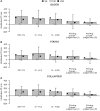Age effects on explicit and implicit memory
- PMID: 24065942
- PMCID: PMC3779811
- DOI: 10.3389/fpsyg.2013.00639
Age effects on explicit and implicit memory
Abstract
It is well-documented that explicit memory (e.g., recognition) declines with age. In contrast, many argue that implicit memory (e.g., priming) is preserved in healthy aging. For example, priming on tasks such as perceptual identification is often not statistically different in groups of young and older adults. Such observations are commonly taken as evidence for distinct explicit and implicit learning/memory systems. In this article we discuss several lines of evidence that challenge this view. We describe how patterns of differential age-related decline may arise from differences in the ways in which the two forms of memory are commonly measured, and review recent research suggesting that under improved measurement methods, implicit memory is not age-invariant. Formal computational models are of considerable utility in revealing the nature of underlying systems. We report the results of applying single and multiple-systems models to data on age effects in implicit and explicit memory. Model comparison clearly favors the single-system view. Implications for the memory systems debate are discussed.
Keywords: aging; implicit memory; models of memory; priming; recognition.
Figures




References
-
- Akaike H. (1973). Information theory and an extension of the maximum likelihood principle, in Second International Symposium on Information Theory, eds Petrov B. N., Caski F. (Budapest: Academiai Kiado; ), 267–281
-
- Berry C. J., Henson R. N. A., Shanks D. R. (2006). On the relationship between repetition priming and recognition memory: insights from a computational model. J. Mem. Lang. 55, 515–533 10.1016/j.jml.2006.08.008 - DOI
LinkOut - more resources
Full Text Sources
Other Literature Sources

